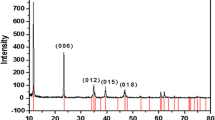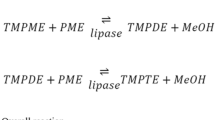Abstract
2-Ethylhexyl palmitate has been prepared in organic solvents catalyzed by an immobilized lipase QLM. Microwave irradiation was used to improve the enzyme activity and shorten the reaction time. The reaction conditions under microwave have been optimized. Compared with that of the free QLM under classical heating, the immobilized QLM under microwave exhibited higher enzyme activity and the conversion could achieve 99% in about 3.0 h. Furthermore, the immobilized QLM displayed excellent reusability under microwave irradiation.





Similar content being viewed by others
References
Zaks, A., & Klibanov, A. M. (1985). Enzyme-catalyzed processes in organic solvents. PNAS, 82(10), 3192–3196. https://doi.org/10.1073/pnas.82.10.3192.
Cantone, S., Hanefeld, U., & Basso, A. (2007). Biocatalysis in non-conventional media—ionic liquids, supercritical fluids and the gas phase. Green Chemistry, 9(9), 954–971. https://doi.org/10.1039/b618893a.
Carrea, G., & Riva, S. (2000). Properties and synthetic applications of enzymes in organic solvents. Angewandte Chemie, International Edition, 39(13), 2226–2254. https://doi.org/10.1002/1521-3773(20000703)39:13<2226::AID-ANIE2226>3.0.CO;2-L.
Choi, J.-M., Han, S.-S., & Kim, H.-S. (2015). Industrial applications of enzyme biocatalysis: current status and future aspects. Biotechnology Advances, 33(7), 1443–1454. https://doi.org/10.1016/j.biotechadv.2015.02.014.
Klibanov, A. M. (1997). Why are enzymes less active in organic solvents than in water? Trends in Biotechnology, 15(3), 97–101. https://doi.org/10.1016/S0167-7799(97)01013-5.
Lee, M.-Y., & Dordick, J. S. (2002). Enzyme activation for nonaqueous media. Current Opinion in Biotechnology, 13(4), 376–384. https://doi.org/10.1016/S0958-1669(02)00337-3.
Serdakowski, A. L., & Dordick, J. S. (2008). Enzyme activation for organic solvents made easy. Trends in Biotechnology, 26(1), 48–54. https://doi.org/10.1016/j.tibtech.2007.10.007.
Larhed, M., Moberg, C., & Hallberg, A. (2002). Microwave-accelerated homogeneous catalysis in organic chemistry. Accounts of Chemical Research, 35(9), 717–727. https://doi.org/10.1021/ar010074v.
Whittaker, A., & Mingos, D. (1994). The application of microwave heating to chemical syntheses. The Journal of Microwave Power and Electromagnetic Energy, 29(4), 195–219. https://doi.org/10.1080/08327823.1994.11688249.
Kappe, C. O. (2004). Controlled microwave heating in modern organic synthesis. Angewandte Chemie, International Edition, 43(46), 6250–6284. https://doi.org/10.1002/anie.200400655.
Roy, I., Gupta, M.N. (2003). Applications of microwaves in biological sciences. Current Science, 1685–1693.
Parker, M.-C., Besson, T., Lamare, S., & Legoy, M.-D. (1996). Microwave radiation can increase the rate of enzyme-catalysed reactions in organic media. Tetrahedron Letters, 37(46), 8383–8386. https://doi.org/10.1016/0040-4039(96)01544-4.
Yadav, G. D., & Lathi, P. S. (2004). Synergism between microwave and enzyme catalysis in intensification of reactions and selectivities: transesterification of methyl acetoacetate with alcohols. Journal of Molecular Catalysis A: Chemical, 223(1), 51–56. https://doi.org/10.1016/j.molcata.2003.09.050.
Carrillo-Munoz, J.-R., Bouvet, D., Guibé-Jampel, E., Loupy, A., & Petit, A. (1996). Microwave-promoted lipase-catalyzed reactions. Resolution of (±)-1-phenylethanol. The Journal of Organic Chemistry, 61(22), 7746–7749.
Yu, D., Wang, Z., Chen, P., Jin, L., Cheng, Y., Zhou, J., & Cao, S. (2007). Microwave-assisted resolution of (R, S)-2-octanol by enzymatic transesterification. Journal of Molecular Catalysis B: Enzymatic, 48(1), 51–57. https://doi.org/10.1016/j.molcatb.2007.06.009.
Tarahomjoo, S., & Alemzadeh, I. (2003). Surfactant production by an enzymatic method. Enzyme and Microbial Technology, 33(1), 33–37. https://doi.org/10.1016/S0141-0229(03)00085-1.
Richetti, A., Leite, S. G., Antunes, O. A., de Souza, A. L., Lerin, L. A., Dallago, R. M., Paroul, N., Di Luccio, M., Oliveira, J. V., & Treichel, H. (2010). Optimization of 2-ethylhexyl palmitate production using Lipozyme RM IM as catalyst in a solvent-free system. Applied Biochemistry and Biotechnology, 160(8), 2498–2508. https://doi.org/10.1007/s12010-009-8756-z.
Richetti, A., Leite, S. G., Antunes, O. A., Lerin, L. A., Dallago, R. M., Emmerich, D., Di Luccio, M., Vladimir Oliveira, J., Treichel, H., & de Oliveira, D. (2010). Assessment of process variables on 2-ethylhexyl palmitate production using Novozym 435 as catalyst in a solvent-free system. Bioprocess and Biosystems Engineering, 33(3), 331–337. https://doi.org/10.1007/s00449-009-0328-7.
He, X.-l., Chen, B.-q., & Tan, T.-w. (2002). Enzymatic synthesis of 2-ethylhexyl esters of fatty acids by immobilized lipase from Candida sp. 99–125. Journal of Molecular Catalysis B: Enzymatic, 18(4), 333–339.
Tan, T., Chen, B.-q., & Ye, H. (2006). Enzymatic synthesis of 2-ethylhexyl palmitate by lipase immobilized on fabric membranes in the batch reactor. Biochemical Engineering Journal, 29(1), 41–45. https://doi.org/10.1016/j.bej.2005.02.033.
Shen, H., Tao, Y., Cui, C., Zhang, Y., Chen, B., & Tan, T. (2015). Synthesis of 2-ethyl hexanol fatty acid esters in a packed bed bioreactor using a lipase immobilized on a textile membrane. Biocatalysis and Biotransformation, 33(1), 44–50. https://doi.org/10.3109/10242422.2015.1018191.
Yu, D., Wang, Z., Zhao, L., Cheng, Y., & Cao, S. (2007). Resolution of 2-octanol by SBA-15 immobilized Pseudomonas sp. lipase. Journal of Molecular Catalysis B: Enzymatic, 48(3), 64–69.
Lowry, O. H., Rosebrough, N. J., Farr, A. L., & Randall, R. J. (1951). Protein measurement with the Folin phenol reagent. The Journal of Biological Chemistry, 193(1), 265–275.
Chen, S.Y., Chen, Y.T., Lee, J.J., et al. (2011). Tuning pore diameter of platelet SBA-15 materials with short mesochannels for enzyme adsorption[J]. Journal of Materials Chemistry, 450 21(15):5693–5703.
Lidström, P., Tierney, J., Wathey, B., & Westman, J. (2001). Microwave assisted organic synthesis—a review. Tetrahedron, 57(45), 9225–9283. https://doi.org/10.1016/S0040-4020(01)00906-1.
Rejasse, B., Lamare, S., Legoy, M.-D., & Besson, T. (2007). Influence of microwave irradiation on enzymatic properties: applications in enzyme chemistry. Journal of Enzyme Inhibition and Medicinal Chemistry, 22(5), 519–527. https://doi.org/10.1080/14756360701424959.
Young, D. D., Nichols, J., Kelly, R. M., & Deiters, A. (2008). Microwave activation of enzymatic catalysis. Journal of the American Chemical Society, 130(31), 10048–10049. https://doi.org/10.1021/ja802404g.
Yu, D., Tian, L., Ma, D., Wu, H., Wang, Z., Wang, L., & Fang, X. (2010). Microwave-assisted fatty acid methyl ester production from soybean oil by Novozym 435. Green Chemistry, 12(5), 844–850. https://doi.org/10.1039/b927073f.
Liu, N., Wang, L., Wang, Z., Jiang, L., Wu, Z., Yue, H., & Xie, X. (2015). Microwave-assisted resolution of α-lipoic acid catalyzed by an ionic liquid co-lyophilized lipase. Molecules, 20(6), 9949–9960. https://doi.org/10.3390/molecules20069949.
Wang, Y., Li, Q., Zhang, Z., Ma, J., & Feng, Y. (2009). Solvent effects on the enantioselectivity of the thermophilic lipase QLM in the resolution of (R, S)-2-octanol and (R, S)-2-pentanol. Journal of Molecular Catalysis B: Enzymatic, 56(2), 146–150. https://doi.org/10.1016/j.molcatb.2008.01.010.
Wilson, L., Palomo, J. M., Fernández-Lorente, G., Illanes, A., Guisán, J. M., & Fernández-Lafuente, R. (2006). Effect of lipase–lipase interactions in the activity, stability and specificity of a lipase from Alcaligenes sp. Enzyme and Microbial Technology, 39(2), 259–264. https://doi.org/10.1016/j.enzmictec.2005.10.015.
Carrea, G., Ottolina, G., & Riva, S. (1995). Role of solvents in the control of enzyme selectivity in organic media. Trends in Biotechnology, 13(2), 63–70. https://doi.org/10.1016/S0167-7799(00)88907-6.
Gorman, L. A. S., & Dordick, J. S. (1992). Organic solvents strip water off enzymes. Biotechnology and Bioengineering, 39(4), 392–397. https://doi.org/10.1002/bit.260390405.
Halling, P. J. (1994). Thermodynamic predictions for biocatalysis in nonconventional media: theory, tests, and recommendations for experimental design and analysis. Enzyme and Microbial Technology, 16(3), 178–206. https://doi.org/10.1016/0141-0229(94)90043-4.
Mattiasson, B., & Adlercreutz, P. (1991). Tailoring the microenvironment of enzymes in water-poor systems. Trends in Biotechnology, 9(1), 394–398. https://doi.org/10.1016/0167-7799(91)90132-2.
Hari Krishna, S., & Karanth, N. (2002). Lipases and lipase-catalyzed esterification reactions in nonaqueous media. Catalysis Reviews, 44(4), 499–591. https://doi.org/10.1081/CR-120015481.
Acknowledgements
We are gratefully for the financial support from the Fund of Basic Scientific Research from Jilin University (for Constructing the Scientific and Technological Platform, 2017) and the Foundation of Changchun BC&HC Pharmaceutical Technology Co., Ltd. (No. 3R116V401465).
Author information
Authors and Affiliations
Corresponding author
Ethics declarations
Conflict of Interest
The authors declare that they have no conflict of interest.
Rights and permissions
About this article
Cite this article
Wang, L., Zhang, Y., Zhang, Y. et al. Synthesis of 2-Ethylhexyl Palmitate Catalyzed by Enzyme Under Microwave. Appl Biochem Biotechnol 185, 347–356 (2018). https://doi.org/10.1007/s12010-017-2666-2
Received:
Accepted:
Published:
Issue Date:
DOI: https://doi.org/10.1007/s12010-017-2666-2




